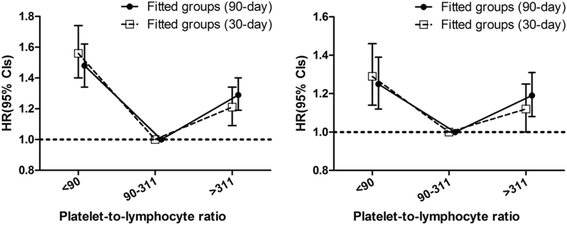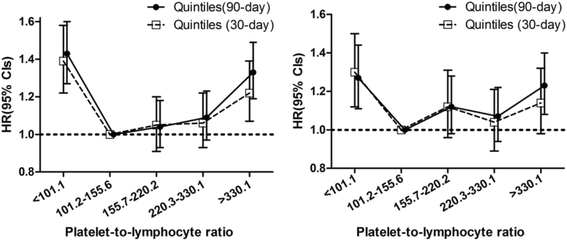Prognostic value of platelet-to-lymphocyte ratios among critically ill patients with acute kidney injury
- PMID: 28882170
- PMCID: PMC5590135
- DOI: 10.1186/s13054-017-1821-z
Prognostic value of platelet-to-lymphocyte ratios among critically ill patients with acute kidney injury
Abstract
Background: Inflammation plays an important role in the initiation and progression of acute kidney injury (AKI). However, evidence regarding the prognostic effect of the platelet-to-lymphocyte ratio (PLR), a novel systemic inflammation marker, among patients with AKI is scarce. In this study, we investigated the value of the PLR in predicting the outcomes of critically ill patients with AKI.
Methods: Patient data were extracted from the Multiparameter Intelligent Monitoring in Intensive Care Database III version 1.3. PLR cutoff values were determined using smooth curve fitting or quintiles and were used to categorize the subjects into groups. The clinical outcomes were 30-day and 90-day mortality in the intensive care unit (ICU). Cox proportional hazards models were used to evaluate the association between the PLR and survival.
Results: A total of 10,859 ICU patients with AKI were enrolled. A total of 2277 thirty-day and 3112 ninety-day deaths occurred. A U-shaped relationship was observed between the PLR and both 90-day and 30-day mortality, with the lowest risk being at values ranging from 90 to 311. The adjusted HR (95% CI) values for 90-day mortality given risk values < 90 and > 311 were 1.25 (1.12-1.39) and 1.19 (1.08-1.31), respectively. Similar trends were observed for 30-day mortality or when quintiles were used to group patients according to the PLR. Statistically significant interactions were found between the PLR and both age and heart rate. Younger patients (aged < 65 years) and those with more rapid heart rates (≥89.4 beats per minute) tended to have poorer prognoses only when the PLR was < 90, whereas older patients (aged ≥ 65 years) and those with slower heart rates (<89.4 beats per minute) had higher risk only when the PLR was > 311 (P < 0.001 for age and P < 0.001 for heart rate).
Conclusions: The preoperative PLR was associated in a U-shaped pattern with survival among patients with AKI. The PLR appears to be a novel, independent prognostic marker of outcomes in critically ill patients with AKI.
Keywords: Acute kidney injury; Intensive care unit; Platelet-to-lymphocyte ratio; Prognosis.
Conflict of interest statement
Consent for publication
Not applicable.
Competing interests
The authors declare that they have no competing interests.
Publisher’s Note
Springer Nature remains neutral with regard to jurisdictional claims in published maps and institutional affiliations.
Figures
Similar articles
-
Platelet-to-Lymphocyte Ratio: A Novel Prognostic Factor for Prediction of 90-day Outcomes in Critically Ill Patients With Diabetic Ketoacidosis.Medicine (Baltimore). 2016 Jan;95(4):e2596. doi: 10.1097/MD.0000000000002596. Medicine (Baltimore). 2016. PMID: 26825908 Free PMC article.
-
Platelet count as a new biomarker for acute kidney injury induced by hemorrhagic shock.Platelets. 2020;31(1):94-102. doi: 10.1080/09537104.2019.1581921. Epub 2019 Feb 27. Platelets. 2020. PMID: 30810451
-
Platelet-to-lymphocyte ratio as a prognostic predictor of mortality for sepsis: interaction effect with disease severity-a retrospective study.BMJ Open. 2019 Jan 25;9(1):e022896. doi: 10.1136/bmjopen-2018-022896. BMJ Open. 2019. PMID: 30782690 Free PMC article.
-
Prognostic value of platelet-to-lymphocyte ratio in neoadjuvant chemotherapy for solid tumors: A PRISMA-compliant meta-analysis.Medicine (Baltimore). 2021 Jul 23;100(29):e26202. doi: 10.1097/MD.0000000000026202. Medicine (Baltimore). 2021. PMID: 34397999 Free PMC article.
-
Platelet to Lymphocyte Ratio in Cardiovascular Diseases: A Systematic Review.Angiology. 2019 Oct;70(9):802-818. doi: 10.1177/0003319719845186. Epub 2019 Apr 28. Angiology. 2019. PMID: 31030530
Cited by
-
The Neutrophil Percentage-to-Albumin Ratio Is Associated with All-Cause Mortality in Critically Ill Patients with Acute Kidney Injury.Biomed Res Int. 2020 Feb 18;2020:5687672. doi: 10.1155/2020/5687672. eCollection 2020. Biomed Res Int. 2020. PMID: 32219136 Free PMC article.
-
Single-Cell Spatial Transcriptomics Unveils Platelet-Fueled Cycling Macrophages for Kidney Fibrosis.Adv Sci (Weinh). 2024 Aug;11(29):e2308505. doi: 10.1002/advs.202308505. Epub 2024 Jun 5. Adv Sci (Weinh). 2024. PMID: 38838052 Free PMC article.
-
Relationship between platelet-to-lymphocyte ratio and early rebleeding after endoscopic variceal ligation: a bicenter retrospective study.Ann Med. 2024 Dec;56(1):2400315. doi: 10.1080/07853890.2024.2400315. Epub 2024 Sep 6. Ann Med. 2024. PMID: 39239880 Free PMC article.
-
The impact of platelet-to-lymphocyte ratio on clinical outcomes in heart failure: a systematic review and meta-analysis.Ther Adv Cardiovasc Dis. 2024 Jan-Dec;18:17539447241227287. doi: 10.1177/17539447241227287. Ther Adv Cardiovasc Dis. 2024. PMID: 38305256 Free PMC article.
-
The Effects of Neutrophil-Lymphocyte Ratio, Platelet-Lymphocyte Ratio and Prognostic Markers in Determining the Mortality in Patients Diagnosed With Pneumonia in Intensive Care.Medeni Med J. 2021;36(2):130-137. doi: 10.5222/MMJ.2021.64160. Epub 2021 Jun 18. Medeni Med J. 2021. PMID: 34239765 Free PMC article.
References
-
- Bellomo R, Ronco C, Kellum JA, Mehta RL, Palevsky P. Acute renal failure - definition, outcome measures, animal models, fluid therapy and information technology needs: the Second International Consensus Conference of the Acute Dialysis Quality Initiative (ADQI) Group. Crit Care. 2004;8(4):R204. doi: 10.1186/cc2872. - DOI - PMC - PubMed
Publication types
MeSH terms
Substances
LinkOut - more resources
Full Text Sources
Other Literature Sources



